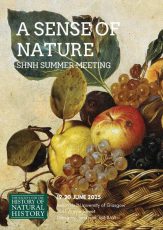
The Sense of Nature: SHNH Summer Meeting, June 2025 by Josephine Koopman
SHNH Summer Meeting
by Josephine Koopman, Researcher (Department of History, European University Institute)
“The senses,” Michel de Montaigne wrote in 1588, “are the beginning and the end of human knowledge”. In true Renaissance spirit, the French essayist thus gave words to the growing importance attached to empirical observation in extending natural knowledge. His dual emphasis on the senses, as both enabling and limiting our understanding of the natural environment, became a recurring theme in the writings of physicians, botanists and other natural history practitioners in the centuries that followed. And it was the leitmotif of the recent annual SHNH International Summer Meeting, ‘A Sense of Nature’. Held at Kelvin Hall, Glasgow, on 19–20 June, the meeting focused on the role of the senses in the history of natural history. It hosted a diverse and passionate group of people, including twelve speakers who explored this rich theme from as many perspectives.

The above quote from Montaigne could be heard on the second day, in Clara Muller’s presentation. It beautifully encapsulates what all the papers, in their own way, brought to the fore: the inevitable ways in which the senses shape our experience and understanding of the world. The question, “can the sense of smell be a source of knowledge?”, with which Clara’s paper opened, could therefore only be answered with affirmation. However, by tracing the changing position of smell in Western learned culture through the early modern period, she demonstrated that the enthusiasm initially shown for engaging all the senses in the study of nature wavered with the Enlightenment.
Francis Taylor’s paper on seventeenth-century biblical natural history made a similar point; the search for a vernacular translation of the ominous Old Testament stinkweed ‘boshah’ took place against the backdrop of transforming natural philosophies in which smell was regarded as less and less epistemologically stable to inform plant names. Its focus on nomenclature resonated nicely with my own paper, which centred on smelling as an epistemic practice in the East Indies. The plant names used by botanists employed by the Dutch East Indies Company in their descriptions of local flora, I argued, point to the (in)commensurability of Indigenous and Western nose knowledge.
More examples of naturalists’ embodied, sensory prose were presented. For example, in Christina Welch’s paper on Alexander Anderson, who served as superintendent of the St. Vincent Botanical Garden in the late eighteenth and early nineteenth centuries. What lingers most from her presentation, however, are not his corporeal plant descriptions, but the botanical illustrations he commissioned from the enigmatic Afro-Caribbean artist John Tyley. Victoria Dickenson’s paper, meanwhile, reminded the audience of the tactile encounters with specimens that underlie natural history illustrations. In the case of feather painting, in which birds were depicted on paper using their own feathers, the handling of bird bodies suddenly becomes very tangible.

The image speaks and promotes understanding of the natural world, but, in the process of revealing, certain aspects are inevitably concealed. This ambivalence, inherent to visual representation, also emerged in Emily Whittingham’s presentation on microscopy in Georgian England. Her paper addressed the ways in which magnification and illumination spoke to a broader culture of theatrics and optical illusion. Likewise, Jiang Hong’s paper on Victorian-era blackberrying excursions underscored that the pursuit of natural knowledge was not merely an activity enjoyed by scholars, but also by less obvious subjects, such as York schoolgirls.
Throughout history, practices associated with natural history have brought satisfaction to experts and amateurs alike precisely because they heightened the senses. Cheryl Tipp and Cam Sharp Jones’s papers worked in tandem to convey some of the sensory pleasures involved with ‘doing’ natural history. Cheryl’s presentation introduced us to the British Library’s collection of wildlife sound recordings. As Cam noted in her paper on the use of sound in natural history displays, for which she used the 2023 British Library exhibition ‘Animals: Art, Science, and Sound’ as a case study, wildlife sounds deepen people’s engagement with nature. I can speak from personal experience that since learning from them that birds have regional accents, I listen to birdsong differently.

In fact, the nature of birdsong has long been a subject of debate, as evidenced by Anne Hehl’s paper on soundscapes in 19th-century German natural history texts. It demonstrated that contemporary scientists and conservationists’ debate about whether birds should be regarded as sound artists or rather as natural producers was strongly influenced by the lyrical descriptions of nature by Romantic poets. That the cultural filters we have colour our scientific imaginary and, ultimately, determine our understanding of nature, also came across in Brooke Penaloza-Patzak’s paper, which deconstructed the tacit sensory assumptions that underpinned the late nineteenth-century notion of a ‘temperate’ climate. But the extent to which sensory practices are historically situated was perhaps most aptly illustrated by the table that Mariana Ladrón de Guevara Zuzunaga showed in her presentation on the Spanish physician Matías de Porres, who worked in Peru in the 1610s. His writings carefully classified the flavours of unfamiliar Andean foodstuffs according to the principles of Galenic humoral theory.
The papers rhymed and were in dialogue with each other, which led to interesting discussions. It was a pleasure to participate in a meeting that conveyed in so many playful ways the extent to which not only the historical actors we study, but we ourselves, indeed rely on our senses to make ‘sense’ of the world around us. It remains for me to express my sincere thanks to the conveners Elle Larsson, Jack Ashby, and Maggie Reilly for organising this wonderful gathering.
Download the 2025 SHNH Programme & Abstracts for ‘A Sense of Nature’.